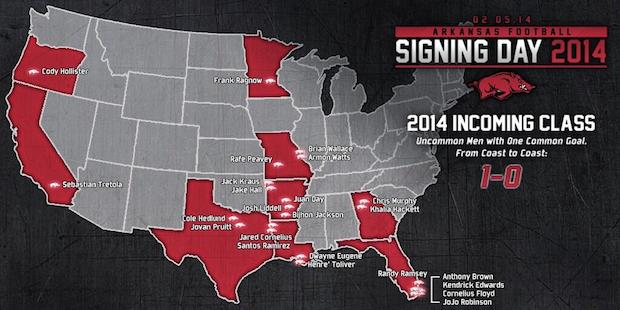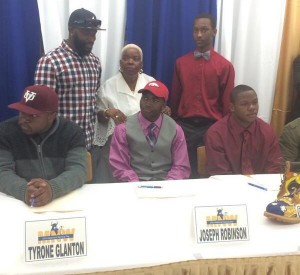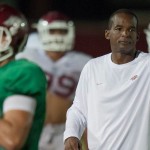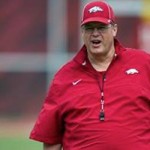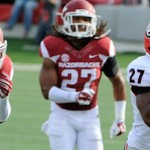 Historically, we know that Arkansas’ signing classes are usually only as good as what the state itself can produce in elite college-bound talent. Razorback football has always supplemented its in-state haul, good or bad, with a few players of widely varying ability from beyond our borders. As anyone with even the slightest knowledge of Hog football knows, much of that extra, better talent came from Texas, even after the Razorbacks joined the Southeastern Conference.
Historically, we know that Arkansas’ signing classes are usually only as good as what the state itself can produce in elite college-bound talent. Razorback football has always supplemented its in-state haul, good or bad, with a few players of widely varying ability from beyond our borders. As anyone with even the slightest knowledge of Hog football knows, much of that extra, better talent came from Texas, even after the Razorbacks joined the Southeastern Conference.
When the in-state production has been solid, like the recruiting seasons over the winter months of 2000-2001 or 2007-08, the overall Razorback recruiting class has been good — maybe those classes weren’t rated by all the services as among the best, but the results on the field bore out that the talent, particularly in the skill positions, was exceptional.
When the state has hit a low ebb in producing big-time talent, such as with the signing classes of 1970 or 2000, the Razorback classes proved to be the worst the program had seen. For those fans and recruiting experts, and even Bret Bielema, who said the 3-9 record this fall affected the recruiting results, realize that the 1970 class was recruiting from one of Arkansas’ greatest seasons that culminated in the Game of the Century with Texas, and the 2000 class was supposed to reap all the glory from a 27-6 plundering of Texas in the Cotton Bowl. Bielema did say Wednesday, and it’s a fair point, that it was easier to sell his past success at Wisconsin last January and February than it was trying to woo recruits with just his Arkansas results. You can also combine 3-9 with the embarrassment of the 2012 season, and back-to-back 52-0 shellackings by Alabama, and see that the name “Arkansas” has quickly lost some stature.
Truth is, not many coaches until Bobby Petrino and, too a greater extent, Bielema, found many sources of star-quality players outside the usual Razorback recruiting base. From Frank Broyles through Kenny Hatfield, the best Hog teams and the mostly Arkie cast were supported by Texas prep stars (Ronnie Caveness and Jerry Lamb were the first big gets out of Texas when Broyles began his run; Hatfield relied on the likes of Barry Foster to power the running game late in his regime), and an occasional game-breaker out of Oklahoma (Harry Jones, Quinn Grovey, for example) or Missouri (e.g. Gary Anderson).
When Arkansas moved to the SEC, Danny Ford found gems in north Louisiana and Mississippi — areas that on rare occasional had helped Broyles’ Hogs with future All-Americans Lance Alworth, Joe Ferguson and Bruce James. Late in Ford’s tenure, he rediscovered Texas for such difference-makers as Clint Stoerner and Kenoy Kennedy, the core to Houston Nutt’s first two teams that challenged the SEC’s best.
Petrino came in with a plan to recruit from coast to coast, but he still tapped into Texas for a handful of greats early on, such as Knile Davis and Cobi Hamilton (and the transfer Ryan Mallett, who had Arkansas roots).
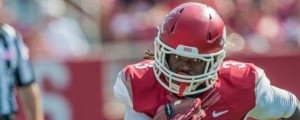 Bielema has had the most impressive beyond-the-recruiting-base results, pulling in more Florida players in two years (nine, including highly acclaimed Alex Collins and Denver Kirkland last year) than Arkansas had attracted total in a generation. The lay of the land today of Arkansas’ latest recruiting haul also looks like one of those political maps, where there is a Razorback Red streak right down the middle of the country from Minnesota to Louisiana.
Bielema has had the most impressive beyond-the-recruiting-base results, pulling in more Florida players in two years (nine, including highly acclaimed Alex Collins and Denver Kirkland last year) than Arkansas had attracted total in a generation. The lay of the land today of Arkansas’ latest recruiting haul also looks like one of those political maps, where there is a Razorback Red streak right down the middle of the country from Minnesota to Louisiana.
Bielema’s not necessarily doing anything wrong when we judge his latest crop of new Razorbacks as a C+. A lot of this boils down to one simple fact: the Hogs signed as many players from Florida — five — as it did from the state of Arkansas, and Bielema’s staff only offered one other in-state player, a four-star who opted for the glamor of Alabama and its nationally top-rated recruiting class. Arkansas went 1-for-2 in a rare year when the state produced TWO 4-star defensive tackles and got the equal to Springdale Har-ber’s Josh Frazier in El Dorado’s Bijhon Jackson.
In the 2015 class, Arkansas may offer 10 or more in-state players and perhaps three or more will be allocated at least 4 stars by the recruiting services, including Charleston quarterback Ty Storey, who has already pledged to the Hogs. Securing most if not all of those players — receiver K.J. Hill and tight end Will Gragg are two who are uncommitted — would quickly push Arkansas up the usual SEC team recruiting rankings without having gone out of state.
Rest assured, Bielema will go out of state because to compete with the 10 SEC teams who ranked ahead of his Hogs on Wednesday in recruiting, he has to find six or seven 4-stars, or difference-makers, in each class.
The Hog faithful was left feeling gut punched bright and early Wednesday when such a difference-maker, defensive end Solomon Thomas of Coppell, Texas, spurned the Hogs and UCLA for Stanford. Ask any recruiting writer for each of that final trio of suitors and all will say the respective coaching staffs felt good about Thomas on Tuesday night.
That’s how recruiting goes. You just don’t know what will really happen until the recruit reaches in the bag for the right hat — or a tree, in Stanford’s case.
But without Thomas, Arkansas’ class was left with just two signees out of the Lone Star State — one should be considered a difference maker even if he only earned 3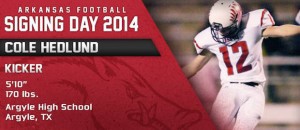 stars from the experts. Kicker Cole Hedlund of Argyle, named last week to the Parade All-America team, fills an immediate need and is the most decorated place-kicker in high school history. The other player is highly regarded Dallas-area offensive lineman Jovan Pruitt, whose “double signing” on Wednesday to Arkansas as well as to Trinity Valley Community College, a two-year school in Texas, leaves observers wondering about his academic status.
stars from the experts. Kicker Cole Hedlund of Argyle, named last week to the Parade All-America team, fills an immediate need and is the most decorated place-kicker in high school history. The other player is highly regarded Dallas-area offensive lineman Jovan Pruitt, whose “double signing” on Wednesday to Arkansas as well as to Trinity Valley Community College, a two-year school in Texas, leaves observers wondering about his academic status.
Mind you, it doesn’t matter where Arkansas finds its better out-of-state players, as long as the Hogs find them. If they can pull a dozen a year out of South Florida — which, remember, is a two-day drive for those kids or their families to Fayetteville unless they can afford to fly every trip — more power to them. Understand that with football now nearly year-round for these guys, going to school for nine months and staying on campus during the summer, being 1,600 miles from home for nearly all of four years is not an easy decision to make.
It just seems to make better sense to tap into the vast talent-rich and much closer area of north and east Texas, where Arkansas has long had a presence, however waning over the past decade. The prospects from the Dallas-Fort Worth Metroplex are a mere 5-6 hours’ drive to the campus. They can actually get home for the weekend. The parents can drive to all the games in Arkansas. Plus, Arkansas will resume playing Texas A&M in Jerry Jones’ Cowboy Stadium for the next 11 years beginning this fall. The Hogs will play a home-and-home series with Texas Tech starting this fall — though one might wonder how that will help Metroplex recruiting — before taking on TCU for two years starting in 2016. Houston prospects and their families only have a short drive over to Arkansas’ every-other-year trip to Baton Rouge, La., too.
Arkansas has let some connections in Texas fall by the wayside since Les Miles was coaching at Oklahoma State and routinely beating Houston Nutt head up for Texas players earlier in the century. This year, in fact, Oklahoma State added 17 more players from Texas to its roster. Bobby Petrino, who followed Nutt, seemed to pollute the waters everywhere he went in Texas, from running off players who were high school coaches’ sons, to just being overly disagreeable with the good folks from the Cotton Bowl. Those stories get around, and Arkansas’ image took a hit over four years.
Bret Bielema, tasked with getting Arkansas competitive again in overall talent and leaning mostly on areas with which he and his staff were more familiar, hasn’t had much time to rebuild the relationships in Texas. That needs to be his chief task in coming weeks.
One or two players a year from a contiguous state that produces such great numbers of D-I football players is far too few, especially in years when Arkansas’ high school football is down in talent.
Bielema claimed last spring he’d be devoting more coaches to Texas, and he echoed the same statement this winter when it was obvious the Hogs’ recruiting there had not turned around. This time, he and his staff must restart a Texas pipeline. It would help if he had even one full-time assistant on his staff that was truly familiar with it and was an ace recruiter.
* * *
We gave the 2014 Razorbacks recruiting class a C+ grade based not on the “stars,” but rather what we feel is the chief criteria to rate a recruiting class: Were needs met?
At cornerback and in the line, Arkansas did well defensively. The Hogs picked up commitments from three defensive backs that likely could play early, and everyone knows they need to at cornerback. Cornelius Floyd, in particular, looks like big-time football player in every way. He played both sides of the football on his Miami prep team and his film shows him pulling away from folks on long runs.
Safety may work out better than it appears today, but for the upcoming season Arkansas signed nobody among the nation’s top safeties who could step in early in a position that was nothing short of a disaster last fall. However, Dollarway’s Josh Liddell may end up being a star in coming seasons.
A big inside linebacker was a huge need and Arkansas whiffed there. The Razorbacks did sign three outside linebacker types and may try to quickly beef them up to SEC standards. Lanky, long-armed Randy Ramsey out of Fort Lauderdale appears to have a good future ahead of him.
The aforementioned Bijhon Jackson and St. Louis product Armon Watts are two potentially good defensive tackles, and Jackson was considered among the top 6 in the country. But the Hogs ought to bring in three a year there. The defensive ends would have gotten a huge boost on signing day with Solomon Thomas or Miami product Demetrius Jackson, but it wasn’t meant to be. That might not matter this fall anyway, but defensive end will again be a priority soon enough after Trey Flowers is gone.
Quarterback appears to be in good hands with the signing of the pass-run dual threat Rafe Peavey, joining a decent crew already on campus and led by starter Brandon Allen.
Running back was already set, but the Hogs added Juan Day, a bullish runner — not as fast as his cousin, Cedric Cobbs, but similarly tough — from North Little Rock.
The receivers got a lift from the recommitment in December of Shreveport Evangel Christian’s Jared Cornelius, along with the signing day bonus of touted Floridian JoJo Robinson, who at one time was pursued by Florida State. Both bring needed speed and good hands to the position. Arkansas also added a bevy of taller targets as well.
But the biggest recruiting improvement occurred in the offensive line, where line coach Sam Pittman worked his magic yet again on the road to bring in St. Louis 4-star tackle Brian Wallace and 3- or 4-star (depending who you ask) tackle Frank Ragnow out of Minnesota. Check out Ragnow’s highlights below and marvel at his ability to move, even on full run when he’s the first man downfield to tackle a punt returner — the kid is an athlete. The Arkansas coaches are already talking the center position for him. Arkansas beat national champ Florida State for Ragnow and out-recruited Alabama for Wallace, which is certainly saying something, even if the experts pegged Arkansas’ overall haul at about No. 30 in the country and 11th in the SEC.


